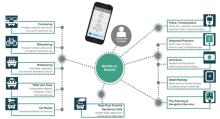Humboldt's public transportation is vital for connecting our local communities to one another, and to farther cities, while providing an affordable and convenient way to get around. Public transportation helps reduce traffic, improves air quality, and makes our communities more livable. HCAOG is committed to supporting and promoting public transportation options that bring benefits to the entire community.
Ride Humboldt! - Transit Rider Information

Plan Your Trip - Humboldt Transit Authority - HTA.org
Get real-time arrivals on your phone with Transit (transitapp.com)
Del Norte Transit - redwoodcoasttransit.org (Route 20 - Crescent City, Smith River, Arcata, Eureka)
Trinity Transit - trinitytransit.org - (Willow Creek to Redding)
Unmet Transit Needs
Whether you ride the bus regularly, occasionally, or haven’t tried transit yet, you have an opportunity to share your thoughts about Humboldt County’s bus and paratransit services annually during the Unmet Transit Needs (UTN) process. Although comments are accepted year round, those received by December 31 of each year will be considered in the fiscal year UTN Report of Findings for the following year. The purpose of the process is to analyze whether there are unmet needs for transit in the region, and especially for riders who are people with low incomes, with disabilities, older than 65, or living in a household without a vehicle. Comments are analyzed to determine if they are reasonable to meet based on adopted criteria.
See the updated Unmet Transit Needs Synopsis which explains how the annual process relates to administering the Local Transportation Fund (LTF), which is one of the major sources of funding for public transit in Humboldt County. If found reasonable to meet, a transit need must be funded prior to using LTF for non-transit purposes.
Opportunities for Public Comment on Unmet Transit Needs
- Take a survey and submit comments online through the 2025 UTN Survey
- Utilize Social Services Transportation Advisory Council (SSTAC) members for information sharing among the community;
- Participate in a public hearing specific to UTN beginning in November/December
- Comment submittals by email (info@hcaog.net), telephone (707-444-8208), mail or in-person at HCAOG's office at 611 I Street, Suite B, Eureka.
Ultimately, HCAOG and transit agencies regionwide would like to hear your realistic thoughts on:
- What changes to the existing transit service would get you to ride more or ride for the first time?
- Would you ride more often if the bus ran more frequently? Time specific details and identification of the transit system are key in determining if the request meets the criteria of “reasonable to meet”.
- Would you choose transit for your transportation needs if the bus went to locations that are currently not accessible by transit? If so please provide details regarding frequency, time of day, days of the week that would serve your needs.
- Do the current transit times meet your transportation needs? If not, what times and days would you realistically ride transit if it was provided? Most transit system schedules are provided on the Humboldt Transit Authority website: https://hta.org/.
Comments submitted will be analyzed by HCAOG and presented to the Social Services Transportation Advisory Council (SSTAC). Comments can also be used to support grant applications for external funding.
Documents
The Transit Development Plan (TDP) is a short-range plan that analyzes the existing transit system, and proposes service alternatives and a capital plan for transit agencies over a five-year period. HCAOG updates the TDP every five years. The HCAOG Board adopted the current TDP 2023-2028 on October 19, 2023.
A California Department of Transportation (Caltrans) Division of Rail and Mass Transportation (DRMT) study to advance the vision for meaningful public transportation access to all parts of the state through the California State Rail Plan and California Intercity Bus Study (CIBS). Intercity bus service is a key element of this vision, providing access to locations that have limited or no rail service available. California’s North Coast US 101 corridor, defined for this report as the 300-mile corridor from Santa Rosa to Crescent City, is one of the largest and most populated corridors in the state that will not be directly served by intercity passenger rail service in the foreseeable future. Providing coordinated, convenient, and efficient bus service along the corridor will be important to keeping this region connected to the rest of the state.
The McKinleyville Transit Study assesses public transportation service within McKinleyville, as well as connections between McKinleyville and nearby communities in Humboldt County.
This document is an update to the 2016 amended Coordinated Public Transit – Human Services Transportation Plan for Humboldt County. Coordinated transportation is essential to keep people linked to social networks, employment, healthcare, education, social services, and recreation. Having access to reliable transportation can present a challenge to vulnerable populations, such as seniors, people with disabilities, and low-income individuals. For these groups, a coordinated transportation plan is necessary to improve access, efficiency, and promote independence.

The Strategic Plan’s overall purpose is to assist the HCAOG in determining the best courses of action to increase multimodal mobility and accessibility in Humboldt County, especially for public transportation and transit, bicycling, walking, rideshare, and other modes separate from single-occupancy vehicle travel. Recommendations included altering the Redwood Transit System route and replacing some segments with a microtransit (or Personal Mobility on Demand) option, and to research technologies such as ridesharing apps.
Humboldt Transit Authority Zero Emission Bus Rollout Plan prepared in accordance with Innovative Clean Transit rule.
